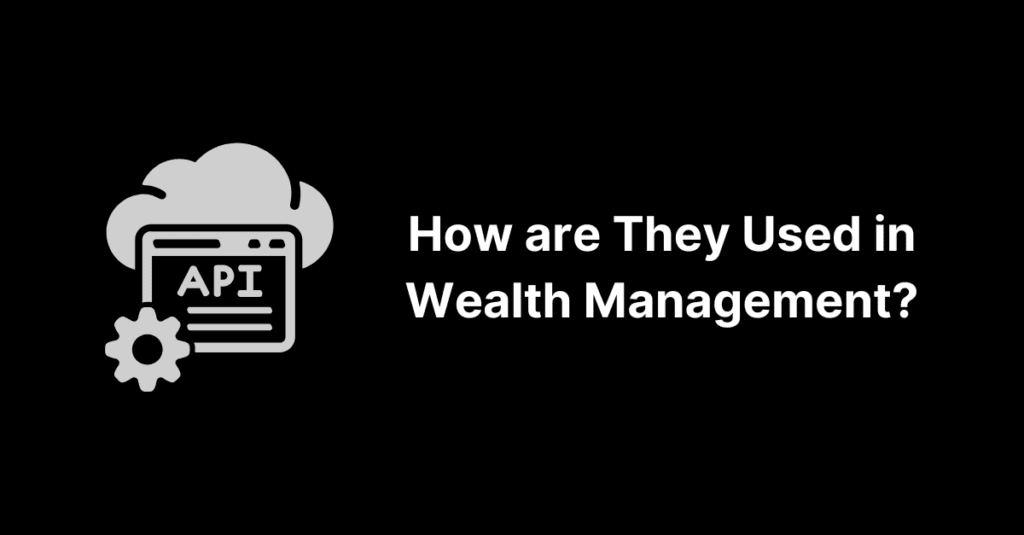Wealth management APIs (application programming interfaces) are rapidly changing the way that the financial services industry operates by allowing for the on-demand exchange of data and seamless interconnectivity of applications and tools. Companies that leverage APIs to power their solutions will be able to provide significantly better and more personalized experiences for their end users and take advantage of the embedded finance movement.
This article will explore how APIs are being used by companies in the wealth management industry.
What is an API?
Application Programming Interfaces (APIs) are mechanisms that enable two software components to communicate with each other using a set of definitions and protocols. For example, the weather app on a smartphone uses an API to “talk” to the weather bureau’s software system. This connection allows the weather app to pull data from the weather bureau software system and show it directly to the phone’s user.
At a high level, when used in the context of the financial services industries, APIs are often used to pull financial data–such as custodial data or market data–into other applications or interfaces. The recent popularity of APIs has led to a movement that industry insiders call embedded finance.
What is Embedded Finance?
Embedded finance–which goes hand-in-hand with APIs– is when a financial product is placed in a non-financial setting. The concept of embedded finance has been around for decades, and a few notable examples include:
- Private-label credit cards at retail chains.
- Loans from car dealerships.
- Point-of-sale financing options for appliances, furniture or other large purchases.
But, in recent years, embedded finance has become much more common due to the rising number of digital interfaces in the modern world. Every day, consumers spend hours scrolling their smartphones, checking out of stores using an iPad, and relaxing at home watching their smart TV. The rise of this digital ecosystem has increased the number of ways for companies to integrate financial tools into everyday life. In other words, it’s easier for wealthtech companies to get their products in front of consumers, and financial advisors, than ever before.

Breaking Down Wealth Management APIs
Wealth applications rely on client and investment account data being streamed into their platform so they can deliver unique and customizable experiences for their clients.
Traditional strategies for accessing this data relied on manual, file-based processes. These strategies typically caused data inaccuracies and led to lengthy processing times, as well as mounting maintenance and labor costs. However, the more modern and flexible approach in wealth management is an API-first strategy. This strategy – using wealth management APIs – is truly changing the game by allowing for the real-time, on-demand exchange of data. This creates the best experience for the end user.
As wealthtech companies continue to innovate, having access to accurate, real-time custodial data will play a crucial role in building the most high-quality solutions for their customers.
5 Distinct Advantages of APIs for Wealth Management Applications
Financial services companies that use wealth management APIs are able to access and consume data/services from independent data providers. This enhances the experience that they offer to their users. Let’s take a closer look at a few of the other benefits of using an API for wealth management applications:
- Modern Approach: An API-based infrastructure supports the scalability of businesses because it leverages the most commonly used technology. This helps position the company for seamless and rapid growth. For organizations looking to future-proof their data processes, APIs are the most effective method.
- Time to Market: APIs are able to connect data from one system to another much faster than other outdated processes leveraging legacy technology. This is because there are no files to be downloaded or batch processes to manage. Instead, data can be accessed on-demand or in as-needed bulk extracts. This significantly reduces development time as one connection eliminates the need for building multiple individual data connections.
- Reduced Costs: A single API connection proves to significantly reduce development costs for firms building wealth apps. Creating individual feeds from multiple sources wastes precious internal resources, but a single API connection build-once, access-many is a more cost-effective option.
- Faster Product Development: APIs increase availability and access to financial, client and investment data. This allows wealthtech firms to develop new products more quickly.
- Wide-Reaching Integration: APIs allow financial services companies to integrate more easily with different financial systems. This allows them to improve their products and user experiences while also potentially taking advantage of the embedded finance ecosystem to get in front of more users.
For companies that are looking to build scalable wealth management solutions, an API-first strategy is crucial.When it comes to offering an API-first WealthTech solution, BridgeFT is leading the way.
APIs in Action: Zoe Financial Partners
Zoe Financial is a one-of-a-kind two-way financial marketplace where individuals can find, hire, and grow their wealth by partnering with trusted financial advisors.
One of the major benefits that Zoe wanted to offer to their advisors was seamless fee billing and client reporting⸺which required accurate, on-time custodial data. To help turn this vision into reality, Zoe Financial turned to BridgeFT.
Zoe’s biggest need was normalizing and processing client account data directly from Zoe’s custodial partner, Apex Clearing. Ultimately, Zoe opted to partner with BridgeFT instead of building their own internal data infrastructure or the business logic and complex calculations required for Fee Billing and Client Reporting needs of their clients. Access to the BridgeFT WealthTech API allowed Zoe to scale their platform quickly and reliably while freeing up crucial developer resources. Ultimately, they were able to get to market much faster by not having to build everything from scratch or rely on standard off-the-shelf applications that don’t offer much, if any, differentiation.
BridgeFT’s WealthTech API
BridgeFT’s WealthTech API is the industry’s only API-first wealth infrastructure framework that delivers critical total wealth data and application needs to build next-generation wealth management and embedded finance applications.
The WealthTech API is the backbone for BridgeFT’s WealthTech-as-a-Service (WtaaS) which is a purpose-built, WealthTech-specific application development and data infrastructure. BridgeFT’s WealthTech-as-a-service enables wealthtechs, TAMPs, RIAs, and investment product distributors to build wealthtech apps more quickly and effectively than ever before.
Some of the core features of BridgeFT’s WtaaS include:
- Multi-custodial and total wealth data aggregation
- Application services for mission-critical advisor tools
- Advanced analytics and insights
We hope that you’ve found this article valuable when it comes to learning about wealth management APIs and embedded finance. Interested in getting started with BridgeFT’s WealthTech API? If so, please contact our team to learn more.

